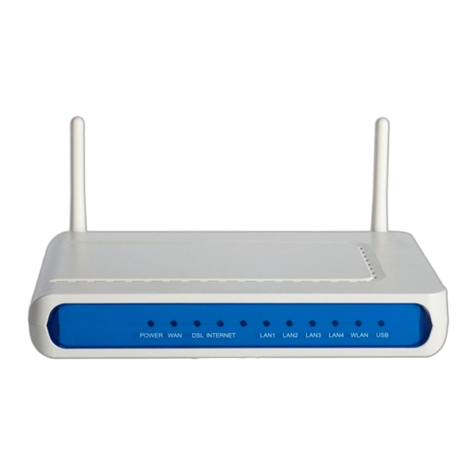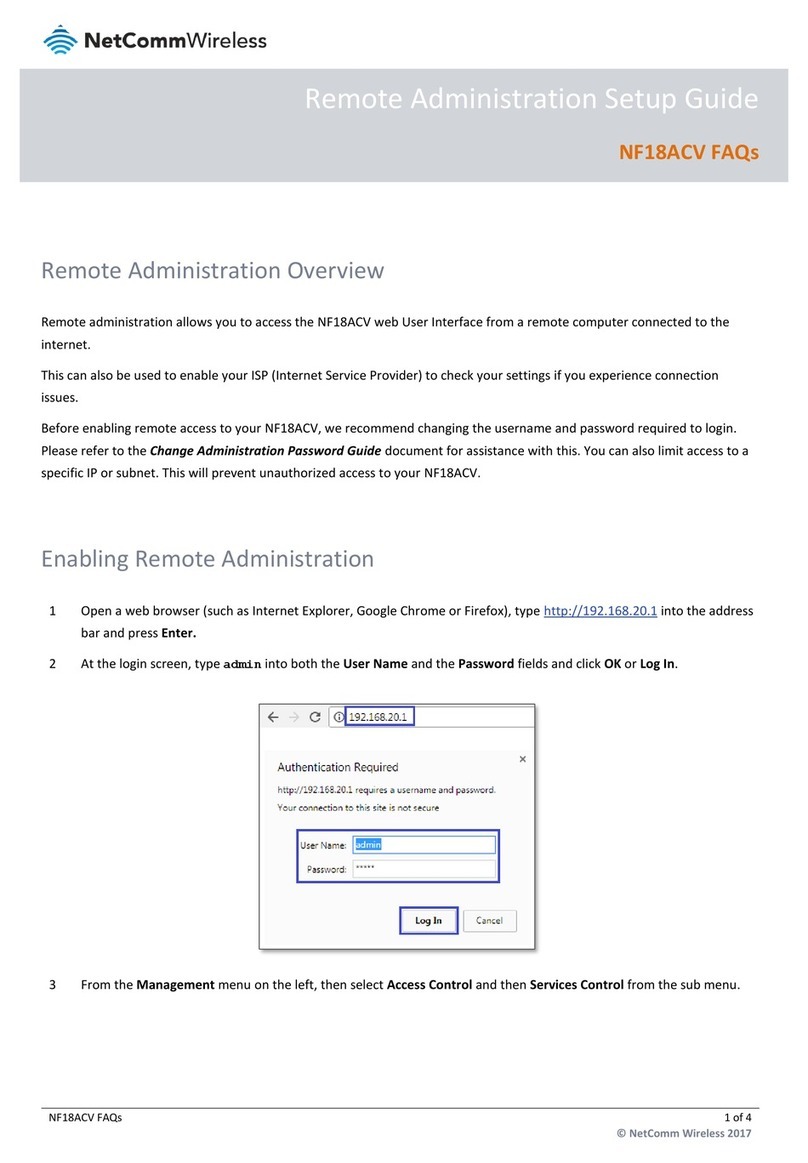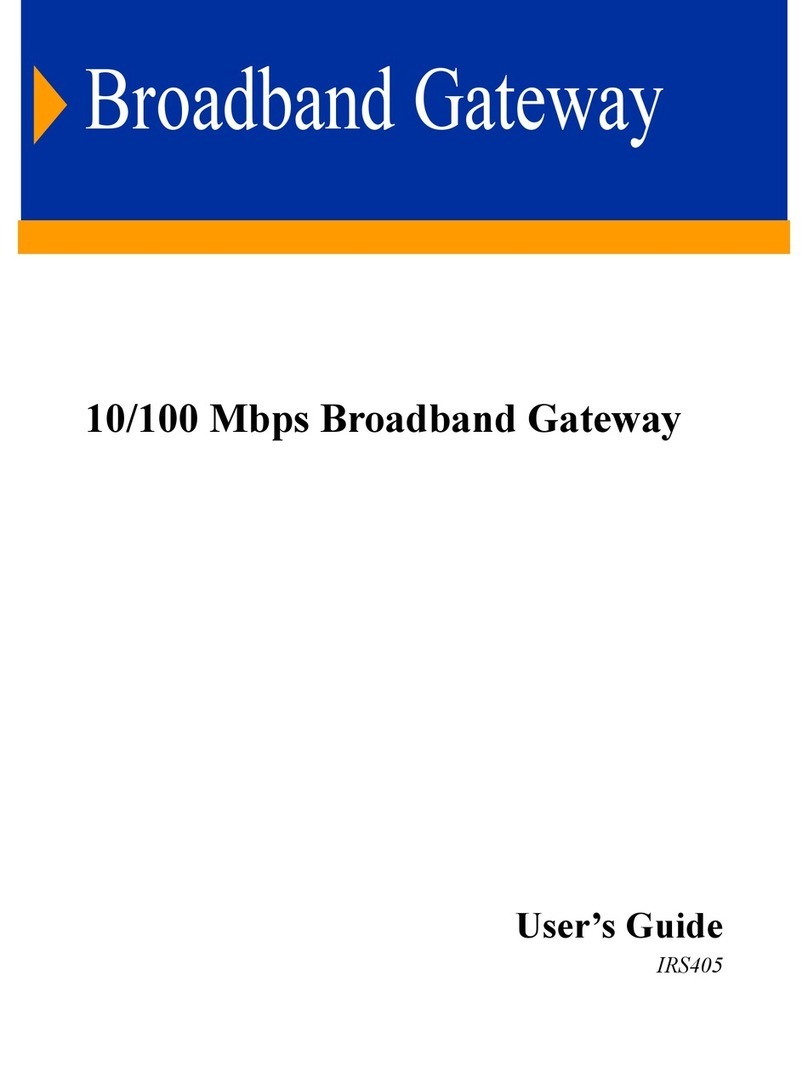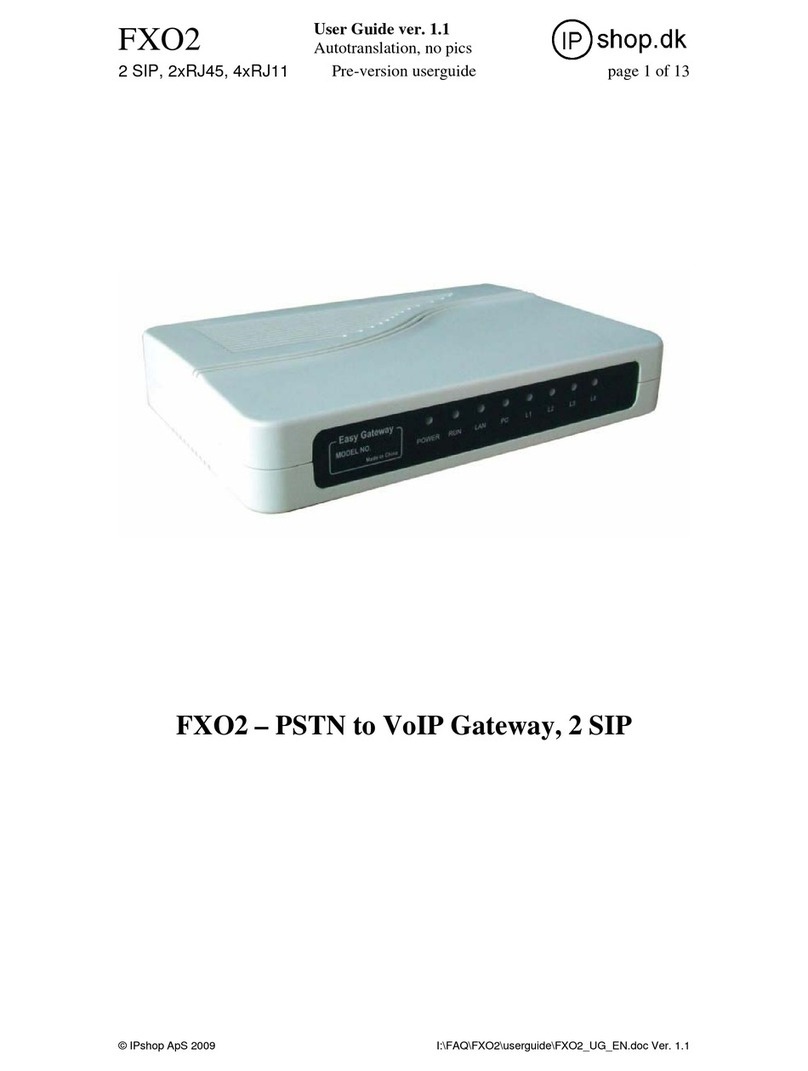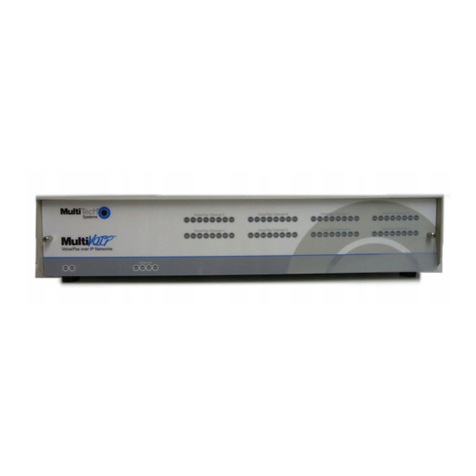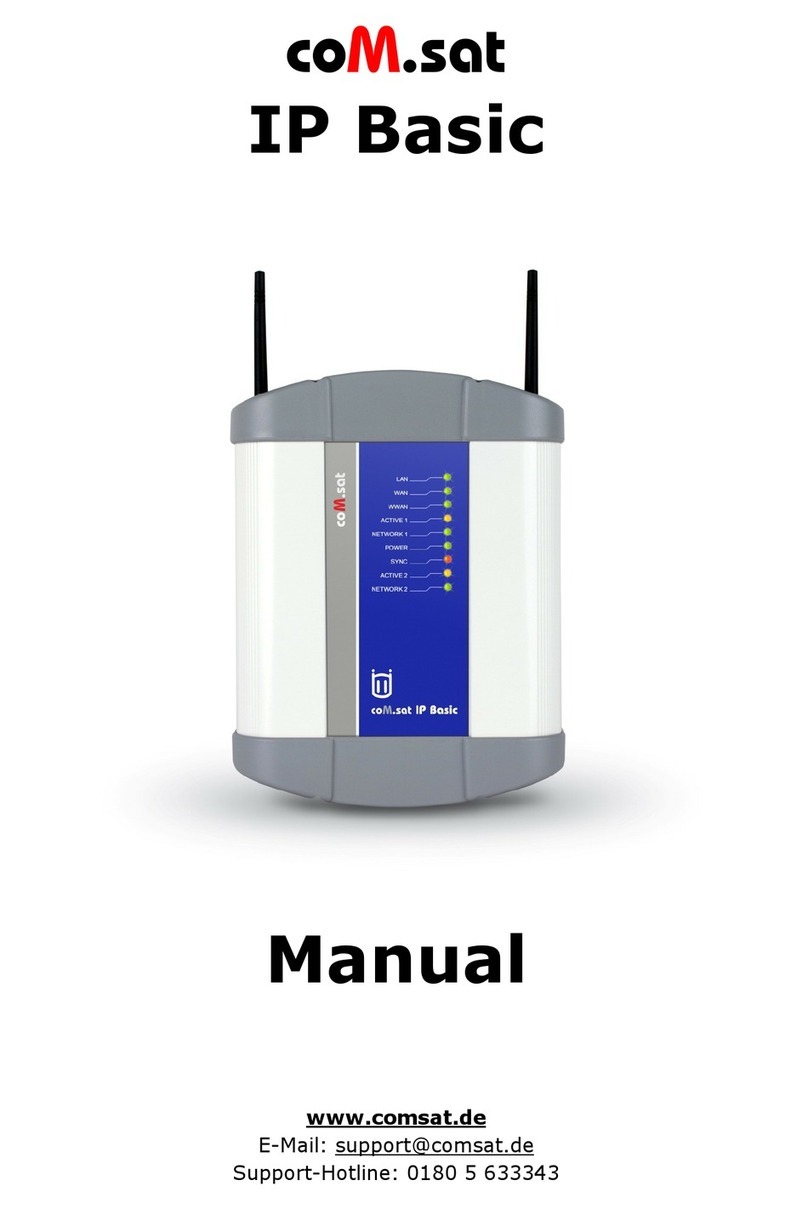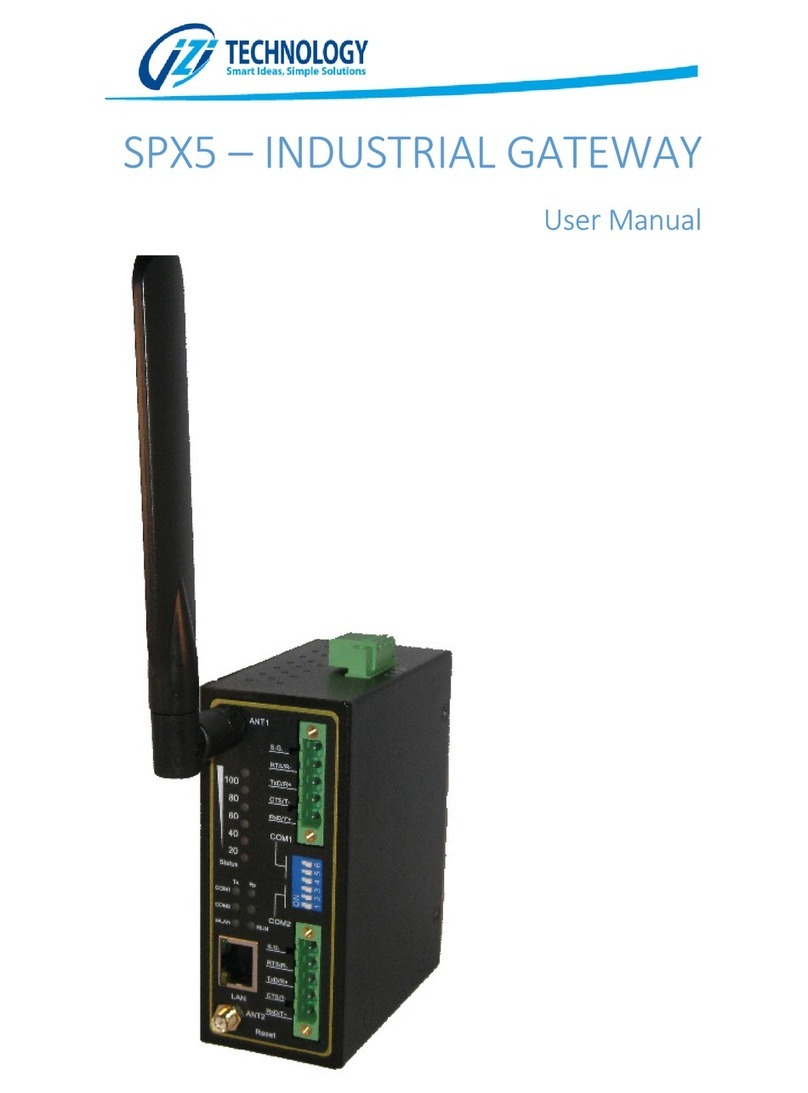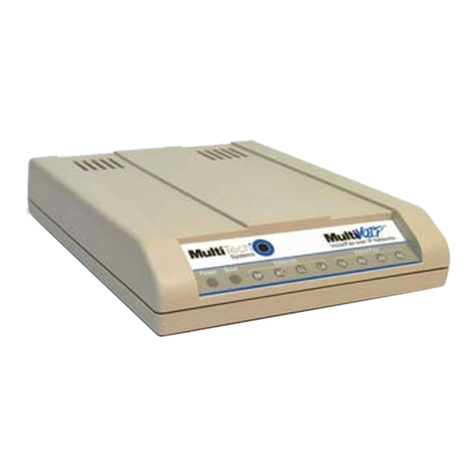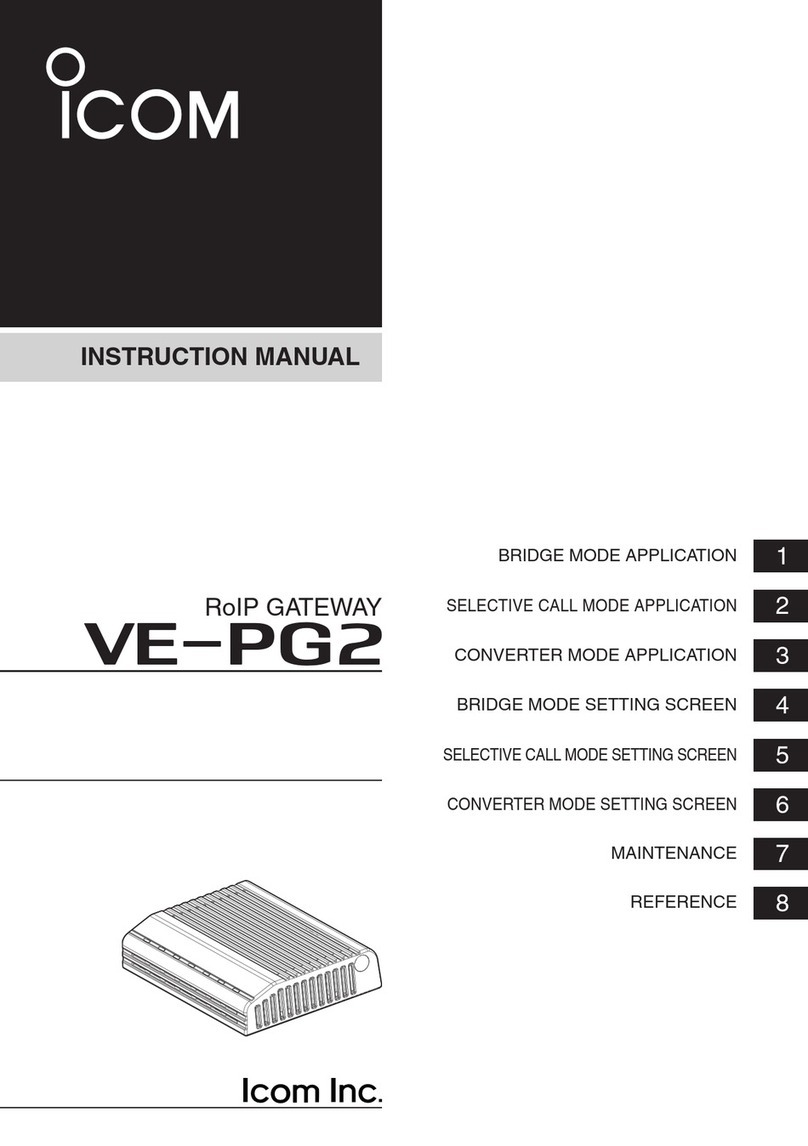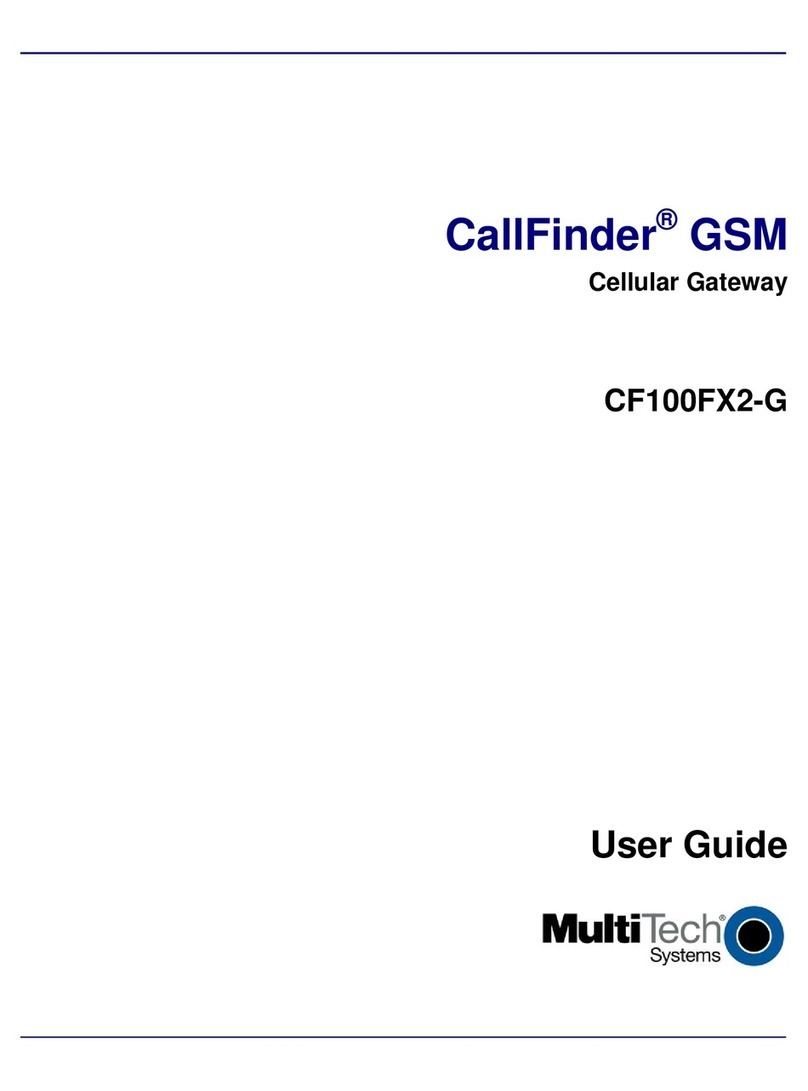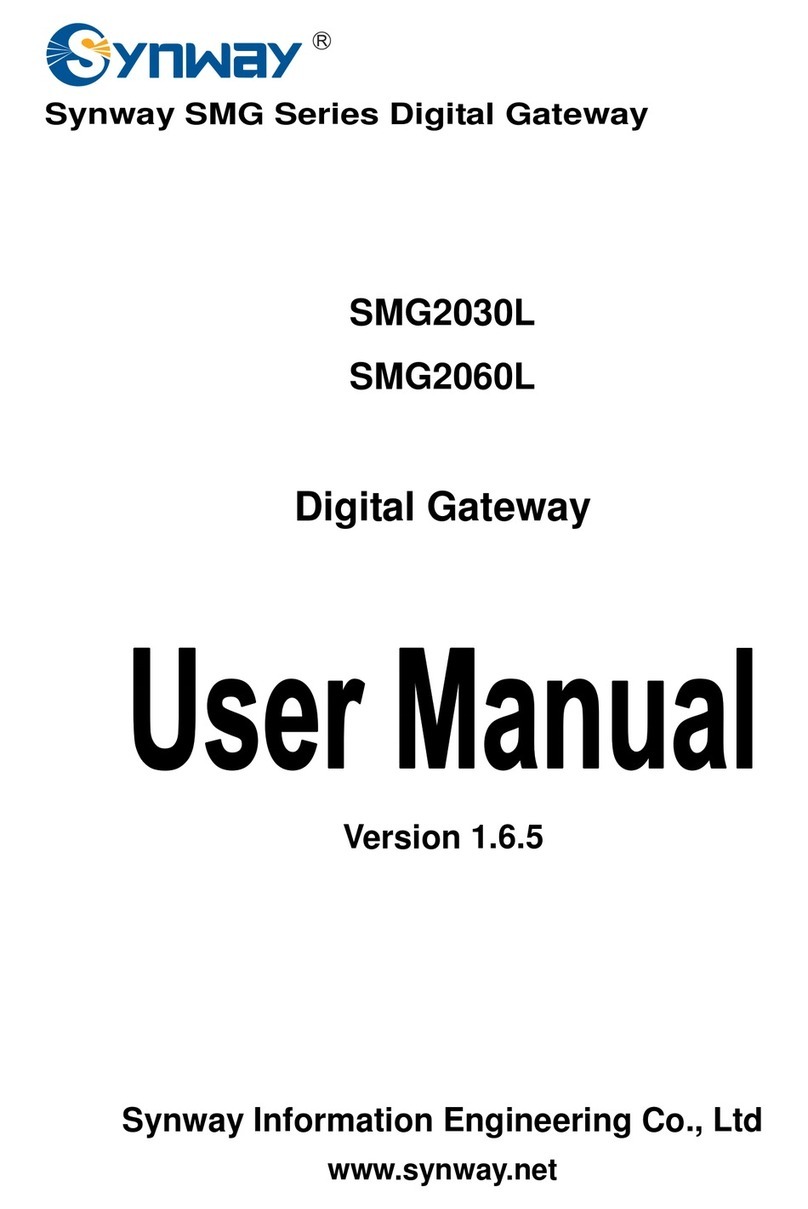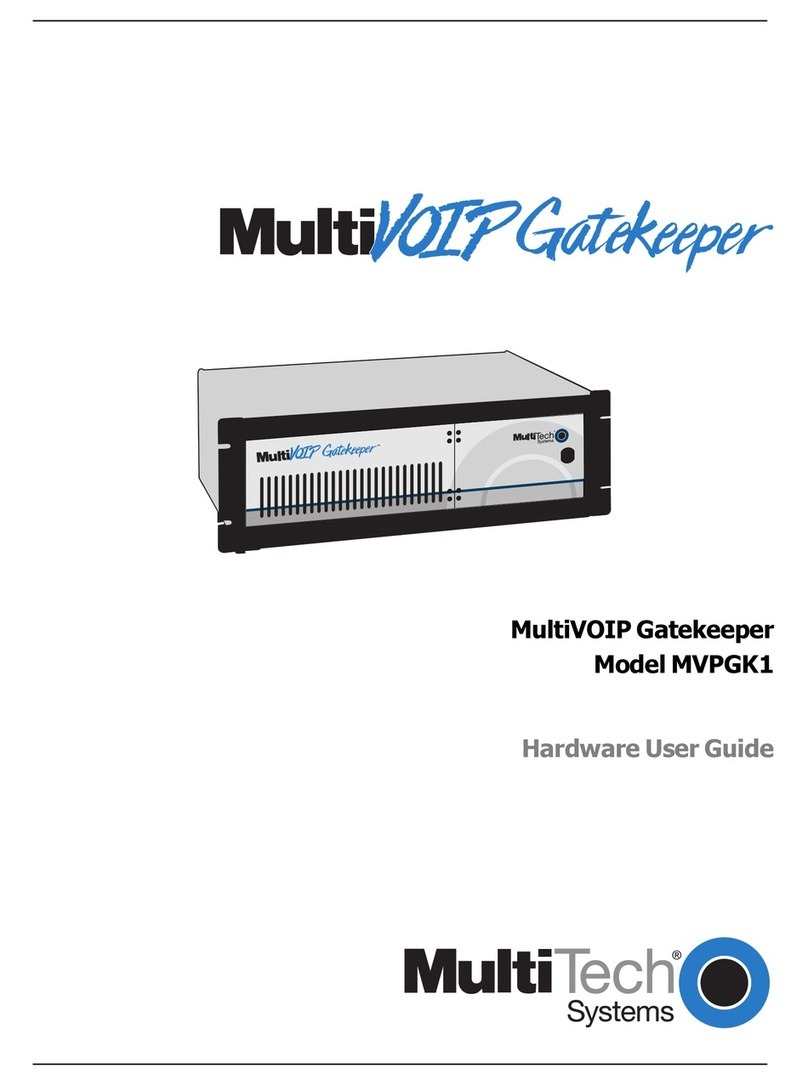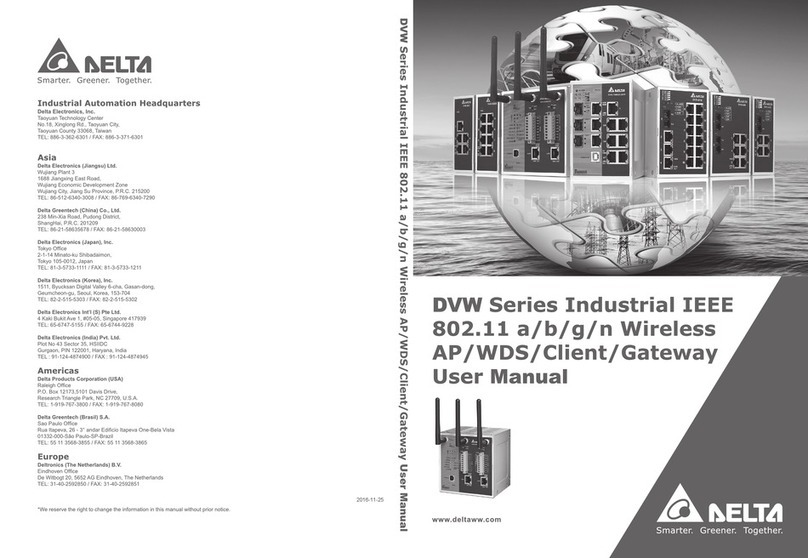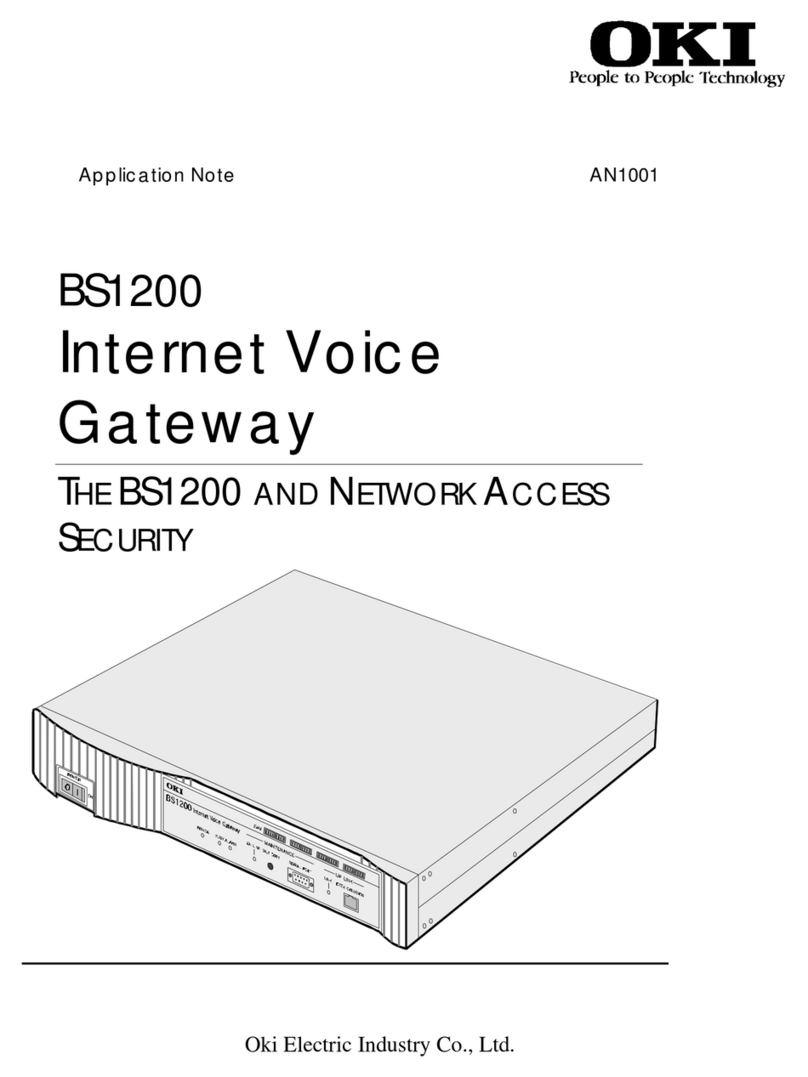tilgin HG2700 Series User manual

Tilgin Home Gateway
HG2700 series
Quick Guide

1
Table of Contents
1. Introduction ..................................................................................................2
2. Delivered with the home gateway.................................................................2
3. Home Gateway Overview.............................................................................3
3.1. Home Gateway cable attachments...............................................................3
3.2. Home Gateway Interfaces............................................................................4
3.3. LEDs Front...................................................................................................5
4. Installing your Home Gateway......................................................................6
4.1 Connecting to the Internet (WAN) ................................................................7
4.2 Connect the power cord to the AC/DC adapter............................................7
4.3 Automatic Provisioning.................................................................................7
4.4 Connecting a computer to your Home Gateway...........................................8
4.4.1 Connecting a computer by Ethernet cable ...................................................8
4.4.2 Connecting a computer by using WLAN(Wireless LAN)...............................8
4.4.2.1 Configuring WLAN Client for computer devices ...........................................9
4.5 Configuring your computer/device................................................................9
4.6 Connecting phones / equipment.................................................................10
4.7 Connecting a DECT handset to the home gateway....................................10
4.8 Locating a DECT handset ..........................................................................11
5. Troubleshooting Tips..................................................................................11
6. Safety Information......................................................................................11
7. Safety Recommendations ..........................................................................12
8. Power Supply.............................................................................................12
9. Technical Specifications.............................................................................14
10. Environmental Information .........................................................................15
11. Warranty.....................................................................................................15
12. Notice of Copyright and Patent Protection .................................................15
13. Acronyms ...................................................................................................15
14. Declaration of Conformity...........................................................................16

2
1. Introduction
The home gateway you have received enables services provided by your operator and can
become the full service node in your home.
This Quick Start Guide contains start-up instructions for installing Tilgin Home Gateway
HG2700 series.
When following the instructions to connect and start-up the home gateway it will automatically
connect to your operator´s network for enabling services offered by your operator. If
provided, check the instructions from your operator for additional steps needed when
connecting and powering up the device.
Quick Guide available on:
https://tilgin.com/company/support/
2. Delivered with the home gateway
Confirm that you have received the following:
All models:
Qty
HG2700 series gateway
1
AC/DC adapter: Output 12V / 3.0 A
1
Ethernet cable yellow or white
1
Quick Guide (this document)
1
EULA, End User License Terms and Conditions
1
Software pre-installed
1
Your operator might also include additional cables or country specific phone
plugs.

3
3. Home Gateway Overview
3.1. Home Gateway cable attachments.
See more instructions below

4
3.2. Home Gateway Interfaces
Pos
Interface
Function
1
Wireless LAN
(WLAN) ON / OFF
Turn wireless LAN (WLAN) ON or OFF with short press. Activate
Wireless Protected Setup (WPS) with push for 10 seconds.
2
DECT
Locate handsets. Press to page (locate) all connected handsets.
3
USB 2 Host Port
Connects USB Device.
4
USB 3 Host Port
Connects USB Device.
5
LAN ports:
1, 2, 3, 4
Connects Ethernet cables (RJ-45) to the home computers and
other devices
6
Phone1 and 2
Connects analogue phones or fax equipment
7
ON / OFF button
Button for turning the home gateway on or off
8
Power Input
Connects the power adapter
9
Reset button
Button for factory reset
10
WAN
Connects to WAN (Internet) using Fiber
11
WAN
Connects to WAN (Internet) using Ethernet
12
WAN
Connects to WAN (Internet) using DSL
Note that some product versions have a subset of the interfaces described above

5
3.3. LEDs Front
Front LEDs indicates the home gateway and its connection status.
LED
Signaling
Indication
Power
GREEN, Stable
Normal operation
GREEN, Rapid flash
Upgrading or connecting to operator
RED, Stable
Not ready, boot in progress
RED, Slow flash
Connection to operator failed
OFF
No power
Internet
GREEN, Stable
Internet Connectivity Established
RED, Stable
No internet Connectivity
WAN
GREEN, Stable
Link 10/100M/1000M
GREEN, Rapid flash
Traffic activity
OFF
No link
LAN
GREEN, Stable
Link 10/100M/1000M
GREEN, Rapid flash
Traffic activity
OFF
No link
WLAN
GREEN, Stable
Wireless function enabled.
GREEN, Slow flash
WPS in progress
GREEN, Short flash
WPS succeeded
GREEN, Rapid flash
WPS failed
OFF
Wireless function disabled
USB
GREEN, Stable
Connection established
OFF
No device connected/detected
Phone
GREEN, Stable
Off –hook
GREEN, Short flash
Ringing
GREEN, Rapid flash
N/A
OFF
Disconnect / on-hook
DECT
Green, slow flash
Pairing in progress
SFP
Green
Detects SFP in slot
Optical Signal
Green
Detects optical signal
Note that some product versions have a subset of the LEDs described above

6
4. Installing your Home Gateway
When the home gateway is connected, it will automatically be provisioned by your operator.
However, the level of configuration can vary from a completely automatic configuration to full
manual configuration, depending on what your operator offers.
Follow the specific configuration instructions you may have received from your operator.
The home gateway use Web GUI pages for local configuration with your computer. Pages
available in the Web GUI depend on your operator’s offering.
Home gateways and power supplies are electrical devices that can overheat without
ventilation.
Place standing or wall mounted on a firm and flat surface and do not cover or crowd them
with objects or clothing that prevents good ventilation.
For best WiFi performance place the unit standing up in a high and free position, preferably in
a central location of the home.
Home gateways must always be installed away from heat sources and direct sunlight.
The flowchart below describes the procedures to install your home gateway and is explained
in detail on the following pages.

7
4.1 Connecting to the Internet (WAN)
Connect the Ethernet cable into WAN port #11 (#10, #12) (on the gateway) and to the
Ethernet access port (SFP fiber access port, DSL access port) offered by the operator.
4.2 Connect the power cord to the AC/DC adapter
1. Connect the AC/DC adapter power cord to the power connector (#8) on the backside of
the unit.
2. Plug the power cord into a power outlet.
3. Push the ON/OFF-Button (#7) on the backside to ON
4. Check that the power LED on the front side is lit (red).
4.3 Automatic Provisioning
When the home gateway is properly connected, an automatic configuration will begin.
The home gateway is pre-loaded with software but it will always download newer software
and settings from your operator.
Just wait until the power LED turns stable green, which normally takes a few minutes, but
may take up to 30 minutes. If the LED still has not turned stable green after 30 minutes, then
reboot (push power ON/OFF-button). If problem persists, contact your operator.
For more information about the LED status, see LEDs Front.

8
4.4 Connecting a computer to your Home Gateway
There are two ways to connect a computer to your home gateway, either with the Ethernet
cable or by using WLAN (Wireless Local Area Network).
Other Ethernet devices or WLAN enabled clients may use same methods to connect.
Note: Some computers can have problems when connecting both Ethernet and WLAN
simultaneously.
4.4.1 Connecting a computer by Ethernet cable
Connect the Ethernet port on your computer with an Ethernet cable to one of the LAN ports
marked LAN 1 –LAN 4.
4.4.2 Connecting a computer by using WLAN(Wireless LAN)
WPS method
The Tilgin Home Gateway supports the Wi-Fi Protected Setup (WPS) feature to make it
easy to set up a secure wireless home network.
Two WPS methods are supported, PIN and Push Button Connect (PBC).
If your wireless device/adapter supplier does not support WPS setup, the WLAN connection
with the home gateway can be setup manually.
WPS-PIN method
-Enable the WLAN by pressing the WiFi-button once (see picture in 3.2 #1). The
WLAN LED on the front will turn green when enabled.
-Enter the PIN code, provided by your wireless device/adapter supplier, in the local
Web GUI of the home gateway.
WPS-PBC method
- Enable the WLAN by pressing the WiFi button once. The WLAN LED on the front
will turn green when enabled.
- Press the WiFi button again for 5-10 seconds to enable the PBC function on the
home gateway.
- Press the PBC button on your wireless device/adaptor.
.
Manual method
The WLAN settings are configured manually according to operator specific WLAN settings
or by using the default WLAN settings of the home gateway.
Note: Your wireless device/adaptor usually has a connection guide or wizard that will guide
you through configuration and connecting to the home gateway.
You should follow these instructions and take into account any WLAN security level settings
provided by your operator.
If the instructions provided with the WLAN client fail, and/or your operator does not
recommend specific WLAN settings, use the default WLAN port settings described in
chapter 4.4.2.1 Configuring WLAN Client for computer devices.

9
4.4.2.1 Configuring WLAN Client for computer devices
The Wireless LAN configuration is dependent on your computer/operating system. For more
detailed instructions refer to your computer operating systems Help.
If you have received instructions from your operator regarding WLAN security level settings,
you should follow these instructions when running the WLAN configuration.
If the configuration fail, and/or your operator do not recommend specific WLAN settings, use
the default WLAN port settings below.
Default WLAN port settings
Check that the parameters for WLAN are set according to SSID and WPA key found on the
casing label on the back of the home gateway.
SSID = Tilgin -<12 random characters>
Example: Tilgin-1wa23sbg9skm
Channel = Auto
Note: Your operator may instruct you to use a WPA key that they provide to you, or use the
WPA key printed on the label on the bottom side of the home gateway.
Make sure your WLAN profile is saved, and make sure your computer network settings are
configured properly.
4.5 Configuring your computer/device
Your computer must be configured properly to be able to connect to the Internet and the
computers network card and network properties must be configured to obtain an IP address
from the home gateway’s built-in DHCP server.
This means that you must check that your computer network settings are set to TCP/IP
protocol and that the IP address will be obtained automatically.
For detailed instructions how to set up your home network check instructions/Help for your
operating system on your computer.

10
4.6 Connecting phones / equipment
You can connect your analogue phones/equipment to the home gateway.
The devices connected to the gateway are adapted for VoIP calls.
Mind that you might need a country specific phone plug and a special phone cable (both
supplied by your operator) to connect multiple analogue devices.
If your services do not include telephony, contact your operator.
Connecting a single analogue phone/equipment
Connect the phone directly to a phone port (see picture in 3.2 #6).
Connecting multiple analogue phones/equipment
All of the phones in your household can be connected to the home gateway using a country
specific phone plug and a special phone cable.
Each port can handle up to five devices in cascade. In this case, DO NOT connect any of the
home gateway phone ports directly to the phone socket on the wall.
Plug the special cable into one of the phone ports (#6) and then into the specific phone plug
connected to the main phone socket on the wall.
DO NOT use an ordinary phone cable for this purpose. It requires a special Phone cable and
can be different from country to country.
This option must be supported in your country and by your operator
4.7 Connecting a DECT handset to the home gateway
If your home gateway is equipped with a built in DECT base station, you can connect DECT
handsets to your home gateway. For the handsets to work properly, they should support
either the CAT-iq or the GAP standard. This is true for most handsets on the market that are
reasonably new. It might also be the case that your operator provides a handset together with
the home gateway.
To connect (or pair) a handset to the home gateway, press the “Page” button (see picture in
3.2 #2) on the home gateway for 5-10 seconds, the DECT LED will start flashing when the
pairing function is activated. Now set the DECT handset in registration mode from the menu
of the handset.
If the handset asks for a PIN to identify itself to the home gateway, use “0000” which is the
default PIN.
When the pairing is completed, the DECT LED on the home gateway will stop flashing, and
the handset will signal that pairing is completed.
Up to 6 handsets can be connected to the home gateway by repeating the procedure above
for each handset.
If you have several phone numbers you can change to which phone number a specific
handset should be associated from the local GUI of the home gateway.
Note that different handsets behave in different ways and that the description above is a
generic description for “any” handset. For details, see the user guide for your DECT handset,
or the information received from the operator if the handset was provided together with the
gateway.

11
4.8 Locating a DECT handset
A feature in the home gateway allows you to located connected DECT handsets.
To locate the handsets press and release the “Page” button on the home gateway. All
connected handsets will start ringing. Press and release the button again to turn off paging
immediately, or wait until paging stops automatically.
5. Troubleshooting Tips
If the home gateway is not working as expected, please try out the following troubleshooting
tips.
•Check that all cables are connected properly.
•Check if the power LED is lit. If not, switch the On/Off button to On.
•If the power LED has not turned stable green within 30 minutes reboot (push power
On/Off). If the power LED still has not turned stable green after reboot, contact your
service operator.
•If the Internet indicator (front of the home gateway) does not lit green check the Ethernet
cable is properly connected (WAN connection, see picture in 3.1).
•Verify that the LEDs lights according to the table shown in 3.3.
•Verify that you can hear a dial tone after hooking off the Telephone receiver. If not check
that the Telephone line cord from the Telephone is connected to one of the phone ports.
•When there is slow, or no connection over WLAN, push the WLAN button (WLAN Off.
Now press the WLAN button again (WLAN On). The Auto channel feature then searches
for the best channel and select it.
•If these actions still do not solve the problem, contact your operator or the vendor
that supplied your home gateway.
6. Safety Information
Tilgin AB products are designed and tested to meet the international Safety of Information
Technology Equipment standard. This standard provides general safety design requirements
that reduce the risk of both personal injury and product injury, protecting against the following
hazards:
Electric shock (hazardous voltage levels)
Fire (overload, temperature, material flammability)
Energy (high energy circuits or potential burn hazards)
Heat (accessible parts of the product at high temperatures)
Radiation (noise, etc.)

12
7. Safety Recommendations
When using the product and to ensure general safety, you are instructed to follow these
guidelines:
•Use only the power supply adapter that comes with the package. Replacement power
supply adapters can be obtained from an authorized Tilgin distributor.
•Do not open or disassemble this product.
•Place on a firm and flat surface.
•Gateways and power supplies are electrical devices that can overheat without ventilation.
Do not cover or crowd them with objects or clothing that prevents good ventilation.
•Do not expose the product to liquid or moisture.
•Do not expose the product to lit candles, cigarettes, open flames, etc.
•Do not drop, throw or try to bend the product.
•Do not allow children to play with the product, as it contains small parts that could be
detached and create a choking hazard.
•Use only original Tilgin components and replacements parts. Failure to do so may result
in performance loss, damage to the product, fire, electric shock or injury. It will also
invalidate the warranty.
•Avoid using the unit during an electrical storm. There may be a remote risk of electric
shock from lightning.
•Treat the product with care, keep it in a clean and dust free place. Use only a soft, damp
cloth to clean the product.
All use of the product is subject to the Safety Recommendations above.
Tilgin waives all and any liability for damages caused to i) the product or any other property
or ii) yourself or any other individual as a consequence of using the product in ways that
deviate from the safety recommendations set out above.
8. Power Supply
Do not use any other power supply than the one delivered by Tilgin. Using the wrong power
supply could be hazardous to you or the product.
The power supply shall be installed near the gateway and shall be easily accessible.
The power supply is approved by one or more of the following safety organizations:

13
1. 2.
3. 4.
Power supplies defined for these products.
1. For EU
CSEC: CS36M120300FGF, Input: 100-240V 50/60Hz 0.8A;
Output: 12VDC 3.0A 36.0W, supplied by Chou Sen Electronics (Shenzhen) Co., Ltd.
Average active efficiency: 87.4% (Min.)
Efficiency at low load (10%): 84.0% (Min.)
No load power consumption: 0.10W (Max.)
2. For UK
CSEC: CS36M120300FBF, Input: 100-240V 50/60Hz 0.8A;
Output: 12VDV 3.0A 36.0W, supplied by Chou Sen Electronics (Shenzhen) Co., Ltd.
Average active efficiency: 87.4% (Min.)
Efficiency at low load (10%): 84.0% (Min.)
No load power consumption: 0.10W (Max.)
3. For EU
CSEC: CS24F120200FGF, Input: 100-240V 50/60Hz 0.8A;
Output: 12V 2.0A 24.0W, supplied by Chou Sen Electronics (Shenzhen) Co., Ltd.
Average active efficiency: 86.2% (Min.)
Efficiency at low load (10%): 81.0% (Min.)
No load power consumption: 0.10W (Max.)

14
4. For UK
CSEC: CS24F120200FBF, Input: 100-240V 50/60Hz 0.8A;
Output: 12V 2.0A 24.0W, supplied by Chou Sen Electronics (Shenzhen) Co., Ltd.
Average active efficiency: 86.2% (Min.)
Efficiency at low load (10%): 81.0% (Min.)
No load power consumption: 0.10W (Max.)
9. Technical Specifications
Max dimension, CPE
W x H x D = 115x222x125mm
Max dimension, Giftbox
W x H x D = 120x283x128mm
Weight, Giftbox
0.92kg
Operating voltage
See the supplied power adapter
Operating frequency
See the supplied power adapter
Temperature
Operating
0°C to 40°C
32°F to 104°F
Non-operating:
-20°C to 60°C
-4°F to 140°F
Humidity (relative, non-
condensing)
Operating
10% to 90%,
Non-operating
5% to 95%
Frequency Band
According to Directive 2014/53/EU
Maximum Radio-Frequency Power (EIRP)
According to Directive 2014/53/EU
WiFi 2412 –2472MHz
WiFi 5150 –5250MHz
WiFi 5250 –5350MHz
WiFi 5470 –5725MHz
DECT 1880 –1900MHz
WiFi 100mW
WiFi 200mW
WiFi 100mW
WiFi 200mW
DECT 250mW
This device is restricted to indoor use when operating in the 5150 MHz - 5350 MHz frequency
range in following countries.
BE
EL
LT
PT
BG
ES
LU
RO
CZ
FR
HU
SI
DK
HR
MT
SK
DE
IT
NL
FI
EE
CY
AT
SE
IE
LV
PL
UK

15
10. Environmental Information
The equipment you purchased has required the extraction and use of natural resources for its
production. It may contain substances that are hazardous to your health and to the
environment. To avoid putting such substances into our environment and to reduce pressure
on our natural resources, we ask that you reuse or recycle your end-life equipment by using
an accredited electronics take-back system.
The symbols below indicate that this product should be reused or recycled and not simply
discarded. Please locate and use an appropriate reuse and recycling site. If you need more
information on collection, reuse and recycling systems, contact your local or regional waste
administration. You may also contact your operator for more information on the
environmental performances of these products.
11. Warranty
No warranty, express or implied, with respect to the product is extended directly to you from
or on behalf of Tilgin AB. Limited warranties may be granted to you by the equipment
provider in its capacity as reseller of the product. Please contact your equipment provider for
information regarding warranties for the product.
12. Notice of Copyright and Patent Protection
This product incorporates technology, which is copyrighted, patented, or otherwise protected
under intellectual property laws and treaties and proprietary to Tilgin AB or Tilgin’s §third
party licensors. All use of the products is subject to the applicable End User License Terms
and Conditions provided in conjunction with the product.
13. Acronyms
DECT
Digital Enhanced Cordless Telecommunications
DHCP
Dynamic Host Configuration Protocol
GUI
Graphical User Interface
LAN
Local Area Network
LED
Light Emitting Diode
PBC Method
Push Button Connect method
SSID
Service Set Identifier
VoIP
Voice over IP
WAN
Wide Area Network
Wi-Fi
Trademark for Wi-Fi Alliance
WLAN
Wireless Local Area Network
WPA
Wi-Fi Protected Access
WPS
Wi-Fi Protected Setup

16
14. Declaration of Conformity
Declaring Organization:
Tilgin AB
Box 1240
164 28 Kista
Sweden
Product Name: Home Gateway
Product Model Name: HG2700 series
We, Tilgin AB, declare under the sole responsibility that the above named product conforms to the essential
requirements of the European Union Directives below.
2014/30/EU The EMC Directive
2014/53/EU The Radio Equipment Directive
2011/65/EU RoHS Directive
The following harmonized standards are those to which the product’s conformance has been verified.
EMC - WAN, LAN, FXS, VoIP, USB EN 55032:2015
EN 55035:2017
EN 61000-3-2:2014
EN 61000-3-3:2013
EMC –DECT Draft EN 301489-6 V2.2.0
EMC –2.4GHz & 5GHz WiFi Draft EN 301489-17 V3.2.0
Draft EN 301489-1 V2.2.0
RF, Health Portion –DECT EN 301406 V2.2.2
RF, Health Portion –2,4GHz WLAN EN 300328 V2.1.1
RF, Health Portion –5GHz WLAN EN 301893 V2.1.1
Health –Safety EN 62368-1:2014 + A11:2017
Health –SAR EN 62311:2008
Transmitter frequency: WiFi 2412-2472 MHz Max EIRP 100mW
Transmitter frequency: WiFi 5150-5250 MHz Max EIRP 200mW
Transmitter frequency: WiFi 5250-5350 MHz Max EIRP 100mW
Transmitter frequency: WiFi 5470-5725 MHz Max EIRP 200mW
Transmitter frequency: DECT 1880–1900 MHz Max EIRP 250mW
Michael Gustavsson
VP Products and Services Tilgin AB
December 19, 2019

17

18
Manufacturer: Importer:
Tilgin AB Tilgin AB
Box 1240 Box 1240
164 28 Kista 164 28 Kista
Sweden Sweden
Copyright © 2019 Tilgin AB
All rights reserved. This Quick Guide and any associated
artwork, software and product designs are copyrighted with all
rights reserved. Under the copyright laws this Quick Guide,
artwork, software, and product designs may not be copied, in
whole or part, without the written consent of Tilgin AB. Under
the law, copying includes translation to another language or
format.
Table of contents
Other tilgin Gateway manuals
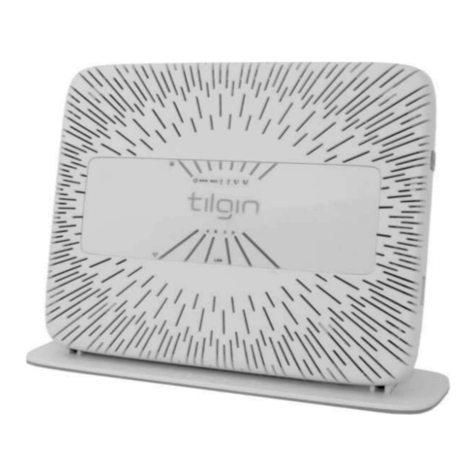
tilgin
tilgin HG2300 series User manual
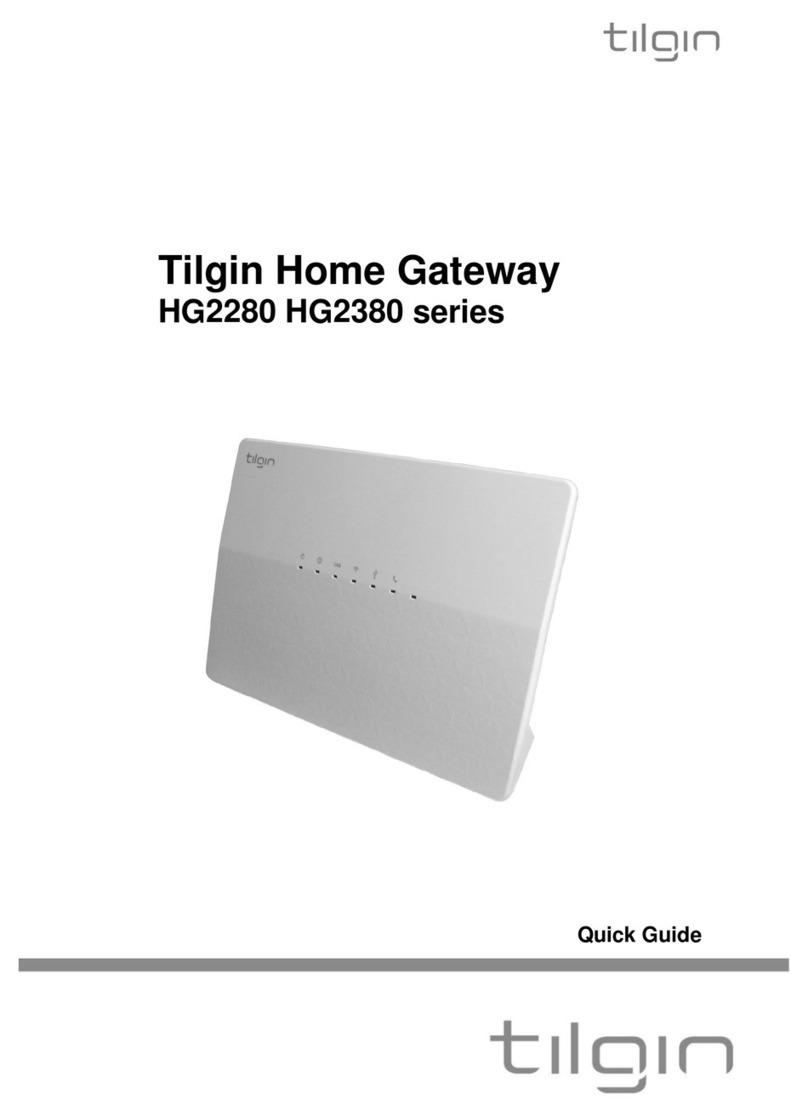
tilgin
tilgin HG2280 series User manual
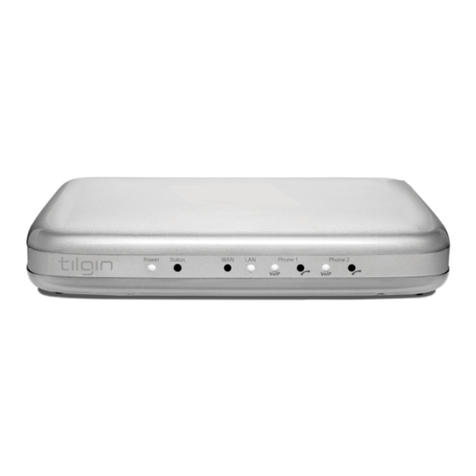
tilgin
tilgin vood 322 User manual
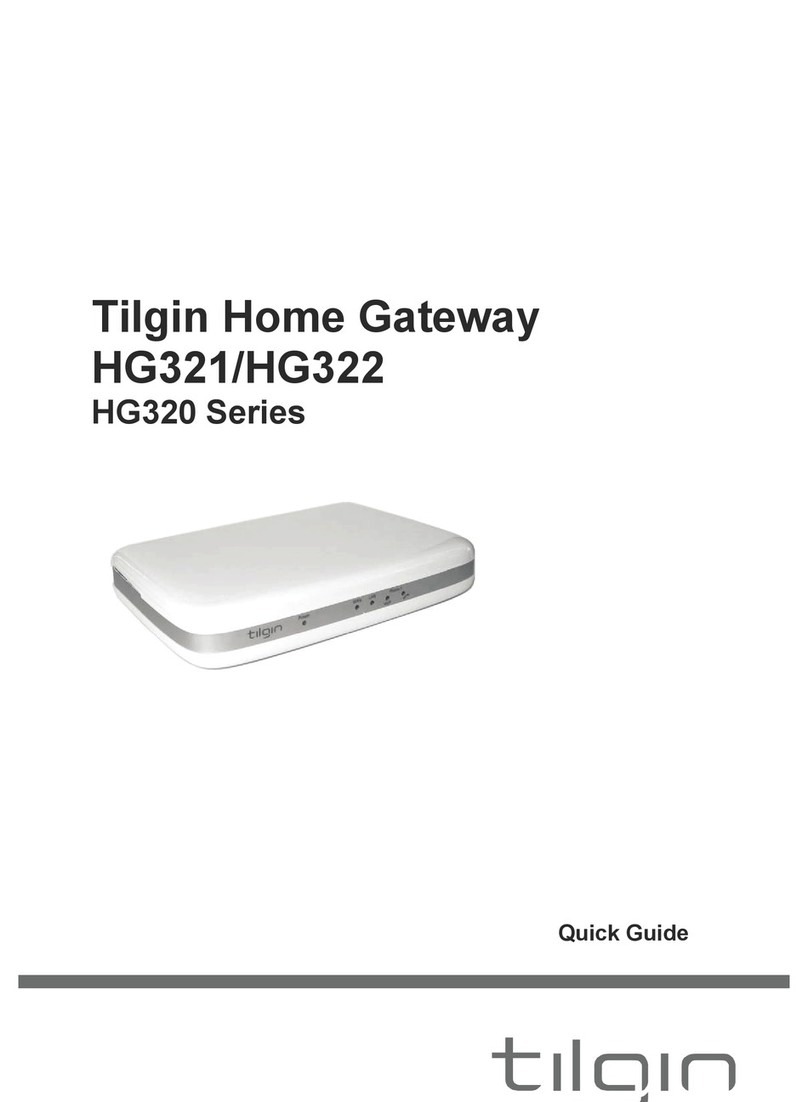
tilgin
tilgin HG321 User manual

tilgin
tilgin HG2500 Series User manual
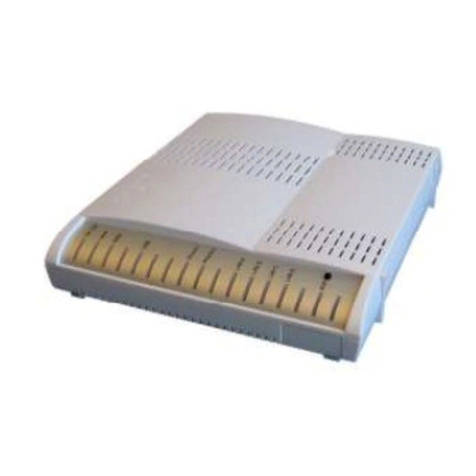
tilgin
tilgin HG2330 series User manual
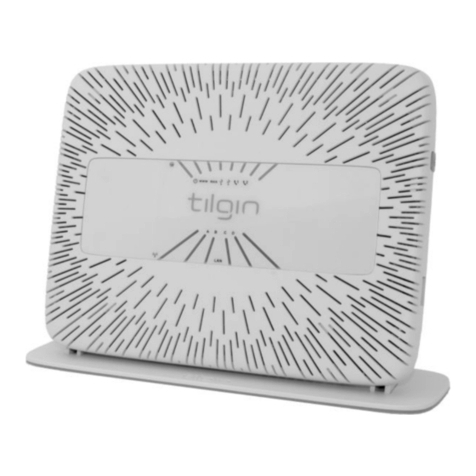
tilgin
tilgin HG2302 User manual
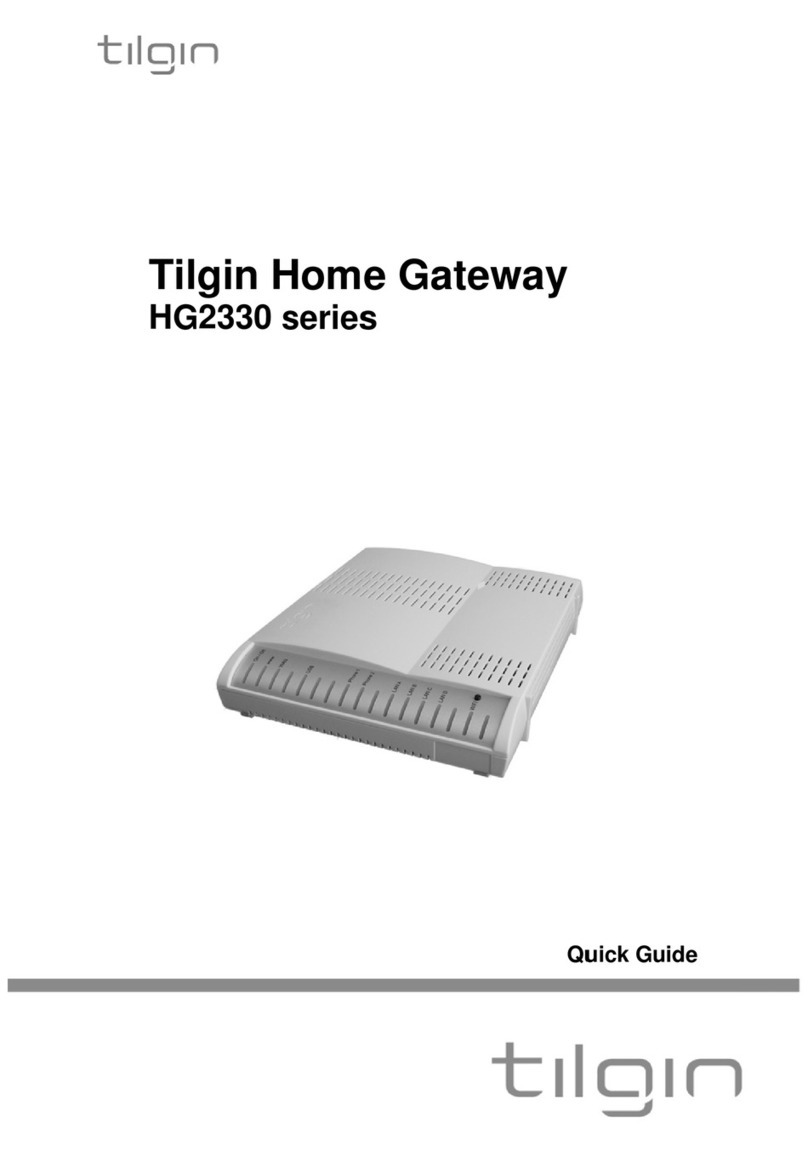
tilgin
tilgin HG2330 series User manual
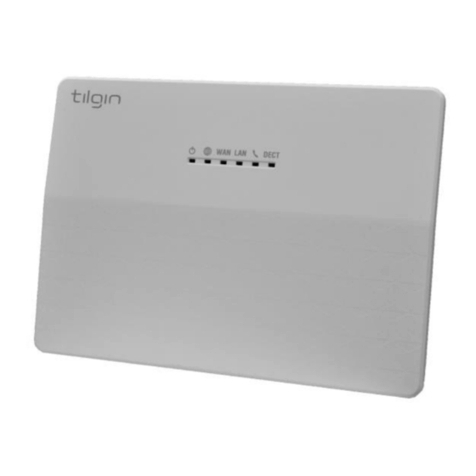
tilgin
tilgin HG350 Series User manual

